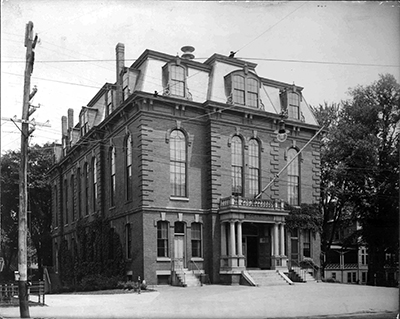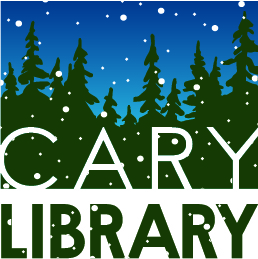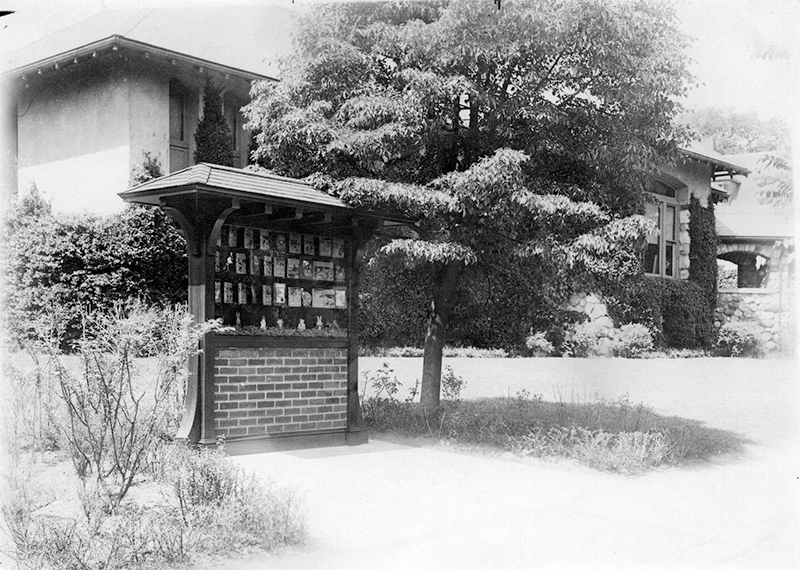Lexington's population more than doubled between 1870 and 1915, to 5,538. Improved access offered by the railroad continued to have a major impact on development: Lexington was being transformed from an isolated agricultural town to a more populated suburb. https://www.lexingtonma.gov/historical-commission/comprehensive-cultural-resources-survey/pages/suburbanization-1870-1915 In addition, organizations such as the Masons (1870), Lexington Historical Society (1886), Field and Garden Club (1891), and a number of literary, social, and financial clubs were formed, indicating an increase in leisure time and cultural/educational interests among Lexington residents.

1868
“Having a regard for her native place and being prompted by a desire to increase the opportunities for culture among its inhabitants…” With these words Maria Hastings Cary offered the Town of Lexington $1,000 for books if a free public library were established. Mrs. Cary's gift carried with it two stipulations: first, the town was to appropriate $1,000 plus $40 yearly for the purchase of books; second, it was to provide a building, maintain it properly, and keep it open without charge to all the inhabitants.
Maria Hastings (1801-1881), after whom Cary Memorial Library is named, was born in 1801, the youngest of nine children. Her father and grandfather, both of whom fought in the Battle of Lexington, were farmers. When she was 27, she married William Harris Cary (1798-1861), whose father, Jonathan Cary, owned a neighboring farm. William and his brother Isaac were wealthy dry goods importers who lived in Boston and New York but spent summers and long visits in Lexington. Maria and William had no children, but Alice Butler Cary (d. 1918), niece of a business partner, was brought up as their own daughter and inherited their property.
On April 20, 1868, Mrs. Cary's gift was accepted and the town agreed to appropriate $1,000 when $400 or its equivalent in books was raised. This provision was overwhelmingly met when the Farmers' Club Library agreed to give its collection of books — 401 volumes valued at $575 — to the town.
A Board of Trustees consisting of the Selectmen, School Committee, and the settled clergy was organized, as stipulated by Mrs. Cary, to oversee the use of the money and the operation of the library. In gratitude to Mrs. Cary for her gift, it was agreed that the new library should bear her name. (Hudson, Vol. I, p. 405)
In addition to the volumes turned over by the Farmers’ Club, 300 volumes belonging to the Lexington Library Association were acquired through gift and purchase. There also were a number of individual gifts, bringing the total to 1,200 books when the library opened its doors in 1869. (Worthen, Tracing the past, p. 147)

1869
On January 27, 1869, Cary Library opened to the public. Located over Bradford Whitcher's (later Spaulding's) Store, which stood on Main Street (now Massachusetts Avenue) opposite Meriam Street, it was open 1:00-5:00 p.m. on Wednesdays and 1:00-8:00 p.m. on Saturdays. Marian S. Keyes was the first librarian and the 1,200 books, all carefully covered in brown paper, were on shelves accessible only to her.
Just one year after the opening of the library, Mrs. Cary proposed constructing a library building. In 1870 a Committee acted on her recommendation and accepted her offer of $20,000 toward building a Town Hall.

1871
The library was moved to the first floor of the newly constructed Town Hall, located on Massachusetts Avenue opposite Waltham Street. Until her death in 1881, Mrs. Cary generously supported the library.
From 1871 to 1906, Cary Library was housed in the rear of Town Hall. All residents over 14 years of age were allowed to borrow books – but only one at a time. Late fees were 5 cents per day. (Kollen, Lexington, p. 109).

1877
Miss Keyes was succeeded as librarian by Grace S. Wellington. During her term and that of her successor, Florence E. Whitcher, Cary Library continued to expand its collections and services.
1881
Maria Hastings Cary died on October 31, 1881, leaving Cary Library $5,000. She was buried in the Green-Wood Cemetery in Brooklyn, New York with her husband, William Harris Cary (who had passed away in 1861).

1883
Library service in the community was expanded further with the opening of a Branch Library in East Lexington. The branch began operation on April 19, 1883 in a reading room of the old Adams School. East Lexington residents could leave their library cards there and receive books from the Main Library twice a week. Miss Nellie Holbrook, the first branch librarian, took the books to and from the Main Library and kept the reading room open "at convenient hours six days of the week." During its first year, the branch had an average of 10 patrons a day.
The reference section of the Main Library was enlarged and the library subscribed to 28 magazines and one daily newspaper. The Trustees reported that, by the end of its first 25 years of service, "Cary Library is filling a larger place in the interest and affection of our people. It was never so much sought and used as today.”
1885
A circulation of over 29,000 volumes represented an average of just over 11 books per resident. (Hudson, Vol. I, p. 406)

1887
WARRANT FOR A TOWN MEETING: Thursday, October 13, 1887. Art. 2: “To see if the Town will accept the proposition of William A. Tower to the Selectmen, in regard to purchasing a site for a Public Library Building, or act in any manner relating thereto.”
William A. Tower, a successful business man who had served in the House of Representatives and on the Governor’s Council and was most active in town affairs, offered to erect a new library building if the town would provide a site, which he indicated should be at the corner of Clarke Street and Massachusetts Avenue. The town voted unanimously to accept his offer. Immediately thereafter, the Reverend Carlton Staples presented a letter from Miss Alice Butler Cary, foster daughter of Maria Hastings Cary and William Harris Cary, stating that the heirs of the Cary estate offered to provide a site, chosen by town committee, not costing over $10,000. According to the minutes, both communications were received with great applause and cheers and committees were formed to negotiate for the site and to investigate the proposed change in library management.
As part of his proposal, Mr. Tower suggested that the Library be run by a “Library Corporation” rather than the existing Trustees (who, by the terms of Mrs. Cary’s original gift, comprised the Selectmen, School Committee and settled ministers). Mr. Tower’s corporation would contain some 30 or 40 citizens as well as the Selectmen and School Committee, but not the ministers. After considerable debate, voter approval, and the involvement of the State legislature, it was left to the Library Trustees to decide whether to relinquish their control. When some of the Trustees resisted Mr. Tower’s plan, the matter was taken to the Massachusetts Supreme Judicial Court, whose bench at the time included the Honorable Oliver Wendell Holmes, Jr. In May 1890, the court decided in favor of maintaining the stipulations of Mrs. Cary’s original gift, and Cary Library’s Board of Trustees has been constructed accordingly ever since.
1888
Mr. Tower had purchased land and buildings at the corner of Clarke Street and Massachusetts Avenue from Asaph W. Phillips, which he conveyed in 1891 to Alice Butler Cary. In 1893 and 1894, Miss Cary purchased additional lands. In January 1905, the land was offered as a gift to the Town for the purpose of building a library. (Tracing the past, pp. 157-161)

1891
As the 103 families living in East Lexington began to use the East Branch, new quarters were sought. In 1891 Miss Ellen Stone offered the Stone building and about one-half acre of land adjoining Follen Church to the Trustees for $2,000. The offer was accepted in 1893, and the East Lexington Branch was moved to the new building from a room over Holbrook's store where it had spent the previous nine months. (Hudson, Vol. I, p. 408)
The Stone building was an interesting acquisition for the town. Erected in 1833-34 by Eli Robbins, it was a place where lectures, sermons, and other meetings were held, and where freedom of speech was allowed. Through the years it had been used as a private school, a meeting place for the Unitarian Society led by Charles Follen, and as a lyceum for lectures. Those who had spoken there included Ralph Waldo Emerson, Charles Sumner, Wendell Phillips, Theodore Parker, and Josiah Quincy, Jr.
1892
“The practice was abandoned of covering books, and in place of the neat brown paper packages that looked so orderly on the shelves there is now a considerable bill for re-binding, denoting the modern notion that books are to be used rather than to be preserved.” (Hudson, Vol. I, p. 409)
1898
The Main Library was open 2:00 p.m. to 8:00 p.m. Monday-Friday, and 2:00 p.m. to 9:00 p.m. on Saturday. The Juvenile Department was established, allowing children to have free access to 1,800 volumes carefully selected for their interest.
1899
“The careless practice of using matches for bookmarks was condemned…” (Hudson, Vol. I, p. 410)

1900
At the turn of the century, Cary Library owned about 20,000 volumes. Circulation had passed 30,000 volumes per year and the librarians were finding increasing demands on their time for aid with reference material. (Tracing the past, pp. 160-161)


1906
The library moved into new quarters at the corner of Massachusetts Avenue and Clarke Street, where it stands today. The building was the gift of Miss Alice Butler Cary in honor of her foster mother. Originally designed by architect Willard Dalrymple Brown, the building faces the Minuteman Statue and the historic Lexington Battle Green.
Local architect Willard Dalrymple Brown (1871-1944) graduated from the MIT School of Architecture in 1894 and set up his own practice in Boston in 1902. Brown's highly original early works reflect the various influences that were prevalent during the eclectic times, including Colonial Revival, Shingle, and Craftsman. The use of fieldstone, stucco, and shingles is common to many of his designs. (https://www.lexingtonma.gov/historical-commission/comprehensive-cultural-resources-survey/pages/suburbanization-1870-1915) The library building echoes the massive fieldstone base of the Minuteman statue just across the street. (Grady, The Architecture of Willard D. Brown, pp. 22-23)
The small farming community of 2,250 now had a library with 2,617 volumes.



























.png)













